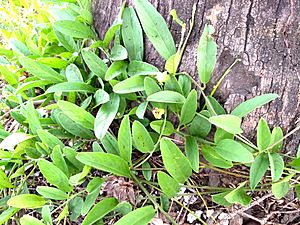Aniseia martinicensis facts for kids
Quick facts for kids Aniseia martinicensis |
|
|---|---|
 |
|
| Conservation status | |
| Scientific classification | |
| Genus: |
Aniseia
|
| Species: |
martinicensis
|
| Synonyms | |
|
|
Aniseia martinicensis is a type of climbing plant. It belongs to the Convolvulaceae family, which includes morning glories. This plant first grew in warm parts of America. Now, you can find it in many tropical and subtropical areas around the world. These include the Pacific Islands, Australia, Asia, and Africa.
People sometimes eat Aniseia martinicensis as a vegetable. It's often used to add variety to meals. Even though it grows in many places, it is considered a rare plant.
Contents
What Aniseia martinicensis Looks Like
This plant grows as a vine. Its stem is soft and green, not woody like a tree branch. The stem can be smooth or have a few hairs.
Leaves, Flowers, and Fruits
The leaves are long and narrow. They are usually 4 to 8 centimeters long. The flowers are mostly found alone where a leaf meets the stem. They have stalks about 5 centimeters long.
The flowers have five green parts called sepals. These sepals protect the flower bud. The outer two sepals are wider than the inner three. The flowers themselves are white and bell-shaped. They are about 2.5 to 3 centimeters long.
After the flowers, the plant produces fruits. These fruits are oval-shaped capsules, about 2 centimeters long. They hold smooth, black seeds inside. In Bangladesh, this plant flowers from September to November.
Where Aniseia martinicensis Grows
This plant is originally from tropical and subtropical parts of America. But it has spread and now grows naturally in many other warm regions.
Native Regions
It is native to countries like:
- Argentina
- Brazil
- Paraguay
- Bolivia
- Peru
- Ecuador
- Colombia
- Venezuela
- Guyana
- Suriname
- French Guiana
- Panama
- Costa Rica
- Trinidad-Tobago
- Nicaragua
- Windward Islands
- El Salvador
- Honduras
- Guatemala
- Mexico
- Leeward Islands
- Belize
- Dominican Republic
- Jamaica
- Puerto Rico
- Haiti
- Cuba
- Florida in the USA
Introduced Regions
It has also been introduced to and grows in:
- Tonga
- Fiji
- Solomon Islands
- Australia (Queensland, Northern Territory)
- Papua Niugini
- Caroline Islands
- Indonesia
- Philippines
- Ryukyu Islands
- Malaysia
- Thailand
- Cambodia
- Vietnam
- Laos
- Myanmar
- India
- East Himalaya
- Bangladesh
- Nepal
- Sri Lanka
- Madagascar
- Mozambique
- Tanzania
- Democratic Republic of the Congo
- Central African Republic
- Angola
- Chad
- Republic of the Congo
- Cameroon
- Niger
- Nigeria
- Gabon
- Benin
- Ghana
- Côte d'Ivoire
- Liberia
- Guinea
- Sierra Leone
- Senegal
- Guinea-Bissau
Where it Lives and How it Grows
Aniseia martinicensis can grow in many different places. It likes both wet and dry areas. You can find it in flooded forests and grasslands. It grows from sea level up to about 499 meters high.
It is an annual plant, which means it completes its life cycle in one year. It often grows along wet edges of swamps. It needs moist ground to thrive. You might see it growing in rice fields. It is also common near coastlines. Sometimes, it appears in forests where trees lose their leaves. It can also be found in grasslands and areas affected by ocean tides.
In a specific district in Bangladesh, this plant is rare. It is found in only a few unused areas around homes. Because of this, it is considered critically endangered there.
Conservation Status
The plant is listed as "Least Concern" for conservation. This means it is not currently at high risk of disappearing. It grows in many places around the world. There are no major known threats to its survival. However, because it is a rare plant in some areas, people still pay attention to its well-being.
Other Names for the Plant
People in different places have different names for Aniseia martinicensis:
- bejuco de pescado (in Argentine Spanish)
- whitejacket (in American English)
- ânnda:t trâkuët (in the Khmer language, meaning "monitor tongue," because its leaves look like a monitor lizard's tongue)
- shadamati (in Bengali, Bangladesh)
How People Use Aniseia martinicensis
The leaves of this plant are sometimes picked and eaten as a vegetable. This is especially common in Indonesia and Malaysia. The seeds are also used in traditional medicine systems.
In Cambodia, during a time of food shortage, people ate the whole plant. This included the stem. Today, it is still used as an extra vegetable in some villages. For example, in a village on the Tonle Sap floodplain, people eat it raw or cooked in soups. They use it when they want different foods in their diet.
History of its Name
This plant was officially named by a Swiss botanist named Jacques Denys Choisy. He named it in 1837. Choisy was also a religious leader and a philosopher. His description of the plant was published in a science journal.
Before Choisy, another botanist, Nikolaus Joseph von Jacquin, had named the plant Convolvulus martinicensis in 1763. Choisy's name later became the accepted one.
See Also
- Convolvulaceae
- Edible plants


